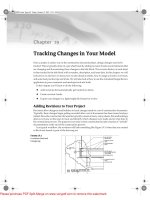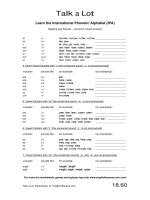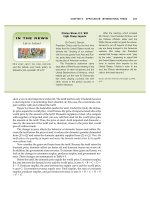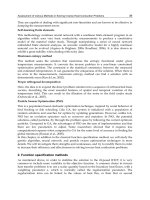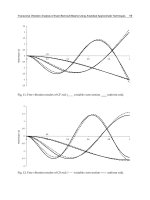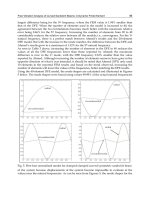MARKETING RESEARCH PART 19 docx
Bạn đang xem bản rút gọn của tài liệu. Xem và tải ngay bản đầy đủ của tài liệu tại đây (454.27 KB, 35 trang )
Regression Analysis
in Marketing Research
Ch 19 2
Understanding Prediction
• Prediction: statement of what is
believed will happen in the future
made on the basis of past experience
or prior observation
Ch 19 3
Understanding Prediction
Two Approaches
• Two approaches to prediction:
–Extrapolation: detects a pattern in
the past and projects it into the
future
–Predictive model: uses
relationships among variables to
make a prediction
Ch 19 4
Understanding Prediction
Goodness of Prediction
• All predictions should be judged as to
their “goodness” (accuracy).
• The goodness of a prediction is
based on examination of the
residuals (errors: comparisons of
predictions to actual values).
Ch 19 5
Analysis of Residuals
Ch 19 6
Linear Relationships and
Regression Analysis
• Regression analysis is a predictive
analysis technique in which one or
more variables are used to predict
the level of another by use of the
straight-line formula, y=a+bx.
Ch 19 7
Bivariate Linear Regression
Analysis
• Bivariate regression analysis is a
type of regression in which only two
variables are used in the regression,
predictive model.
• One variable is termed the dependent
variable (y), the other is termed the
independent variable (x).
• The independent variable is used to
predict the dependent variable, and it
is the x in the regression formula.
Ch 19 8
Bivariate Linear Regression
Analysis
• With bivariate analysis, one variable
is used to predict another variable.
• The straight-line equation is the basis
of regression analysis.
Ch 19 9
Bivariate Linear Regression
Analysis
Ch 19 10
Bivariate Linear Regression
Analysis: Basic Procedure
• Independent variable: used to predict
the independent variable (x in the
regression straight-line equation)
• Dependent variable: that which is
predicted (y in the regression
straight-line equation)
• Least squares criterion: used in
regression analysis; guarantees that
the “best” straight-line slope and
intercept will be calculated
Ch 19 11
Bivariate Linear Regression
Analysis: Basic Procedure
• The regression model, intercept, and
slope must always be tested for
statistical significance
• Regression analysis predictions are
estimates that have some amount of
error in them
• Standard error of the estimate: used
to calculate a range of the prediction
made with a regression equation
Ch 19 12
Testing for Statistical Significance
of the Intercept and the Slope
• The t test is used to determine
whether the intercepts and slope are
significantly different from 0 (the null
hypothesis).
• If the computed t value is greater
than the table t value, the null
hypothesis is not supported.
Ch 19 13
Making a Prediction
Ch 19 14
Bivariate Linear Regression
Analysis: Basic Procedure
• Regression predictions are made with
confidence intervals.
Ch 19 15
Multiple Regression Analysis
• Multiple regression analysis uses the
same concepts as bivariate
regression analysis, but uses more
than one independent variable.
• General conceptual model identifies
independent and dependent variables
and shows their basic relationships to
one another.
Ch 19 16
Multiple Regression Analysis:
A Conceptual Model
Ch 19 17
Multiple Regression Analysis
• Multiple regression means that you
have more than one independent
variable to predict a single dependent
variable
Ch 19 18
Example of Multiple
Regression
Ch 19 19
Example of Multiple
Regression
• We wish to predict customers’
intentions to purchase a Lexus
automobile.
• We performed a survey that included
an attitude-toward-Lexus variable, a
word-of-mouth variable, and an
income variable.
• Here is the result:
Ch 19 20
Example of Multiple
Regression
• This multiple regression equation
means that we can predict a
consumer’s intention to buy a Lexus
level if you know three variables:
–Attitude toward Lexus,
–Friends’ negative comments about
Lexus, and
–Income level using a scale with 10
income grades.
Ch 19 21
Example of Multiple
Regression
• Calculation of Lexus purchase intention
using the multiple regression equation:
• Multiple regression is a powerful tool
because it tells us which factors predict
the dependent variable, which way (the
sign) each factor influences the
dependent variable, and even how much
(the size of b) each factor influences it.
Ch 19 22
Example of Multiple
Regression
• Basic assumptions:
–A regression plane is used instead
of a line
–A coefficient of determination
(multiple R) indicates how well the
independent variables can predict
the dependent variable in multiple
regression
Ch 19 23
Example of Multiple
Regression
• Basic assumptions:
–Independence assumption: the
independent variables must be
statistically independent and
uncorrelated with one another
–Variance inflation factor (VIF) can
be used to assess and eliminate
multicollinearity
Ch 19 24
Multiple R
• Multiple R: also called the coefficient
of determination, is a measure of the
strength of the overall linear
relationship in multiple regression.
Ch 19 25
Multiple R
• Multiple R ranges from 0 to +1 and
represents the amount of the
dependent variable is “explained,” or
accounted for, by the combined
independent variables.
• Researchers mentally convert the
Multiple R into a percentage: Multiple
R of .75 means that the regression
findings explain 75% of the
dependent variable.
